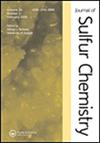新型绿色纳米催化剂Fe3O4@Dop-Triazine-CuCl2在杂环化合物C-Se偶联反应中的构建
IF 1.6
3区 化学
Q3 CHEMISTRY, MULTIDISCIPLINARY
引用次数: 0
摘要
在本研究中,我们首先通过简单的方法制备Fe3O4@Dop-Triazine-CuCl2纳米催化剂,然后通过芳基碘化物与粉末硒和各种杂环化合物衍生物(具有活性的C-H键)的C-Se偶联反应,研究了其在制备芳基-杂芳基和二杂芳基硒化物衍生物中的催化活性。催化剂呈球形,直径约为20 ~ 30 nm,磁饱和矩为50.032 emu/g。经测量,其碳氢化合物含量约为12%(重量比)。在此方法中,以[BMIM]PF6为溶剂,在KHCO3存在下,以Fe3O4@Dop-Triazine-CuCl2纳米材料的催化量合成了多种芳基-杂芳基和二杂芳基硒化物(36例),收率高达85-97%。该方法具有收率高、反应时间适宜(4 h)、催化体系适用于多种底物、Fe3O4@Dop-Triazine-CuCl2催化剂效率高、分离简单、纳米催化剂可重复使用等显著特点。本文章由计算机程序翻译,如有差异,请以英文原文为准。
Construction of Fe3O4@Dop-Triazine-CuCl2 as a novel and green nanocatalyst for C–Se coupling reaction of heterocyclic compounds
In this research, we first fabricated Fe3O4@Dop-Triazine-CuCl2 nanocatalyst by simple method, then its catalytic activity was investigated in the preparation of various derivatives of aryl-heteroaryl and di-heteroaryl selenides through C–Se coupling reactions of aryl iodides with powder selenium and various derivatives of heterocyclic compounds (with active C–H bonds). The catalyst exhibited spherical morphology with a diameter of approximately 20–30 nm and a magnetic saturation moment of 50.032 emu/g. The hydrocarbon content was measured to be around 12% by weight. In this method, a wide range of aryl-heteroaryl and di-heteroaryl selenides (36 examples) were synthesized with high yields (85–97%) using catalytic amount of the Fe3O4@Dop-Triazine-CuCl2 nanomaterial in the presence of KHCO3 in [BMIM]PF6 as solvent. This method has several remarkable features, which can be mentioned as follows: the synthesis of aryl-heteroaryl and di-heteroaryl selenide derivatives with high yields, performing the reactions in a suitable time (4 h), the applicability of this catalytic system for a wide range of substrates, the use of ionic liquid as solvent, high efficiency of Fe3O4@Dop-Triazine-CuCl2 catalyst, simple separation and high reusability of nanocatalyst.
求助全文
通过发布文献求助,成功后即可免费获取论文全文。
去求助
来源期刊

Journal of Sulfur Chemistry
CHEMISTRY, MULTIDISCIPLINARY-
CiteScore
4.10
自引率
9.10%
发文量
38
审稿时长
6-12 weeks
期刊介绍:
The Journal of Sulfur Chemistry is an international journal for the dissemination of scientific results in the rapidly expanding realm of sulfur chemistry. The journal publishes high quality reviews, full papers and communications in the following areas: organic and inorganic chemistry, industrial chemistry, materials and polymer chemistry, biological chemistry and interdisciplinary studies directly related to sulfur science.
Papers outlining theoretical, physical, mechanistic or synthetic studies pertaining to sulfur chemistry are welcome. Hence the target audience is made up of academic and industrial chemists with peripheral or focused interests in sulfur chemistry. Manuscripts that truly define the aims of the journal include, but are not limited to, those that offer: a) innovative use of sulfur reagents; b) new synthetic approaches to sulfur-containing biomolecules, materials or organic and organometallic compounds; c) theoretical and physical studies that facilitate the understanding of sulfur structure, bonding or reactivity; d) catalytic, selective, synthetically useful or noteworthy transformations of sulfur containing molecules; e) industrial applications of sulfur chemistry; f) unique sulfur atom or molecule involvement in interfacial phenomena; g) descriptions of solid phase or combinatorial methods involving sulfur containing substrates. Submissions pertaining to related atoms such as selenium and tellurium are also welcome. Articles offering routine heterocycle formation through established reactions of sulfur containing substrates are outside the scope of the journal.
 求助内容:
求助内容: 应助结果提醒方式:
应助结果提醒方式:


